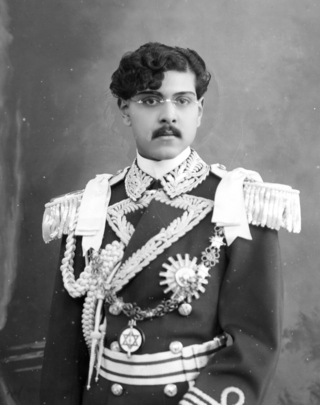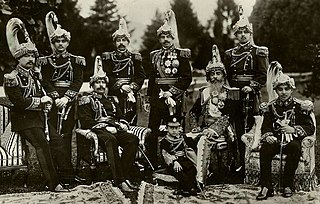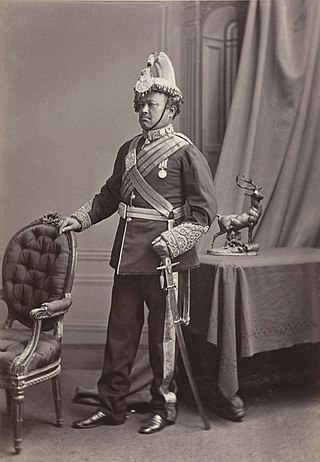
The Kingdom of Nepal was a Hindu kingdom in South Asia, formed in 1768 by the expansion of Gorkha Kingdom, which lasted until 2008 when the kingdom became the Federal Democratic Republic of Nepal. It was also known as the Gorkha Empire, or sometimes Asal Hindustan. Founded by King Prithvi Narayan Shah, a Gorkha monarch who claimed to be of Khas Thakuri origin, it existed for 240 years until the abolition of the Nepalese monarchy in 2008. During this period, Nepal was formally under the rule of the Shah dynasty, which exercised varying degrees of power during the kingdom's existence.

Tribhuvan Bir Bikram Shah was King of Nepal from 11 December 1911 until his death. Born in Kathmandu, the capital city of Nepal, he ascended to the throne at the age of five, upon the death of his father, Prithvi Bir Bikram Shah, and was crowned on 20 February 1913 at the Nasal Chowk, Hanuman Dhoka Palace in Kathmandu, with his mother acting as regent. At the time of his crowning, the position of monarch was largely ceremonial, with the real governing power residing with the Rana family.

Jung Bahadur Kunwar Ranaji, belonging to the Kunwar family was a Khas Chhetri ruler of Nepal and founder of the Rana Regime in Nepal. Jung Bahadur took control of the government after killing an alleged usurper Gagan Singh, who was accused of plotting with the junior queen in 1846 to become prime minister by putting the queen's son on the throne. His original name was Bir Narsingh Kunwar but he was popularly known as Jang Bahadur, a name given to him by his maternal uncle Mathabar Singh Thapa. Mathabar Singh Thapa used to call Jang Bahadur Jangay for his boldness.

The Prime Minister of Nepal is the head of government of Nepal. Together with their Council of Ministers, the prime minister exercises executive power in the country.

The Rana dynasty was a Chhetri dynasty that imposed totalitarianism in the Kingdom of Nepal from 1846 until 1951, reducing the Shah monarch to a figurehead and making the Prime Minister and other government positions held by the Ranas hereditary. They are Kshatriya, whose ancestor descended from the Ranas of Udaipur, Rajasthan. Rana dynasty is historically known for the iron-fisted rule. This changed after the Revolution of 1951 with the promulgation of a new constitution, when power shifted back to the monarchy of King Tribhuvan.

Ranaudip Singh Bahadur Kunwar Ranaji, KCSI, commonly known as Ranodip Singh Kunwar was the second Prime Minister of Nepal from the Rana dynasty. His style was His Excellency Commanding General Shree Shree Shree Maharaja Sir.

The Government of Nepal is the federal executive authority of Nepal. Prior to the abolition of the Nepali monarchy in 2006, it was officially known as His Majesty's Government.

Kaji was a title and position used by nobility of Gorkha Kingdom (1559–1768) and Kingdom of Nepal between 1768 and 1846. Many other contemporary kingdoms used the same title for their ministers.

Bal Narsingh Kunwar or Balanarsingh Kanwar posthumously referred as Bal Narsingh Kunwar Rana was a Kaji, military officer and governor in the Kingdom of Nepal.
Amar Singh Thapa, distinguished as Sanukaji Amar Singh Thapa was a Nepalese military commander, courtier, minister and regional administrator. He was born as the youngest son of one of the leading Gorkhali Bharadar Birabhadra Thapa. He led battles against many independent principalities in Nepal and a battle against Tibet. He was a Governor of Palpa and retained the post till his death in 1814.

Thapa dynasty or Thapa noble family was a Kshatriya political family that handled Nepali administration affairs between 1806 and 1837 A.D. and 1843 to 1845 A.D. as Mukhtiyar. This was one of the four noble families to be involved in the active politics of the Kingdom of Nepal, along with the Shah dynasty, Basnyat family, and the Pande dynasty before the rise of the Rana dynastyor Kunwar family. At the end of 18th century, Thapas had extreme dominance over Nepalese Darbar politics alternatively contesting for central power against the Pande family. Bir Bhadra Thapa was a Thapa of Chhetri group and leading Bharadar during Unification of Nepal. His grandson Bhimsen Thapa became Mukhtiyar of Nepal and established Thapa dynasty to the dominating position of central court politics of Nepal.
Ranajit Pande was Nepalese politician, military personnel and courtier in the Kingdom of Nepal. He was member of the Gora Pande clan of Gorkha. He became Mulkaji of Nepal for a brief period in 1804 A.D.

The Pande family or Pande dynasty was a Rajput-Chhetri political family that directly ruled Nepali administration affairs since the 16th century to 19th century as Mulkaji and Mukhtiyar. This dynasty/family was one of the four noble family to be involved in active politics of Nepal together with Shah dynasty, Basnyat family and Thapa dynasty before rise of Rana dynasty. Pande dynasty is the oldest noble family to hold the title of Kaji. This family was decimated from political power in 1843 CE from the political massacre conducted by Prime Minister Mathabar Singh Thapa as a revenge for his uncle Bhimsen's death in 1839.
Dalbhanjan Pande or Dalabhanjan Pande was a Nepalese minister, politician and military officer of the aristocratic Pande family. He had held ministerial positions and military offices. He jointly headed the military administration of Nepal in 1837 along with Mukhtiyar Rana Jang Pande.

Mulkaji was the position of head of executive of Kingdom of Nepal in the late 18th and early 19th centuries. It was equivalent to Prime Minister of Nepal. There were 5 Mulkajis appointed between 1785 and 1804.
The Kunwar family was a noble Khas-Chhetri family in the Gorkha Kingdom and the Kingdom of Nepal. Kunwars were linked to the Thapa dynasty and family of Amar Singh Thapa by marital lineages and, thus, to Pande dynasty through the Thapa dynasty. Three branches of the Kunwars; Ramakrishna, Jayakrishna and Amar Singh Kunwar were formed with opposite political aspirations. Bal Narsingh Kunwar supported Mukhtiyar Bhimsen Thapa while Chandrabir Kunwar supported Bada Kaji Amar Singh Thapa due to their marital relations with those families. Later, the Ramakrishna section of the family including Amarsingh established the Rana dynasty of Nepal and styled themselves as Rana Rajputs while Jayakrishna most section remained as Kunwars.
Tularam Pande was Nepalese military personnel, diplomat and politician in the Gorkha Kingdom. He was a diplomat who served King Prithvi Narayan Shah of Gorkha. Two of his diplomatic missions were with Dolakha and Kathmandu while the latter remained unsuccessful. He also served as the national military commanders in the forces of Prithvi Narayan Shah. He was the patron of the Gora Pande clan, a minor faction of the Gorkha-based aristocratic Pande family. Some of his patrilineal descendants became influential politicians such as Ranajit Pande and Dalabhanjan Pande in the Nepalese history through their marital ties with the Thapa dynasty. His matrilineal descendants became significantly influential; Queen Tripurasundari of Nepal went on to become Queen Mother of Nepal and Mathawar Singh Thapa – the Prime Minister of Nepal and Jang Bahadur Kunwar Ranaji – the latter period ruler of Kaski and Lamjung and Prime Minister of Nepal.

Dhir Shumsher Kunwar after 1848 known as Dhir Shumsher Kunwar Ranaji or Dhir Shumsher Jang Kunwar Ranaji or shortly Dhir Shumsher Rana posthumously known as Dhir Shumsher Jang Bahadur Rana was a Nepalese politician, army general and minister of state. He served as the Commander-In-Chief of the Nepalese Army from 1879 to 1884 A.D. He was born in Kunwar family as the youngest son of Kaji Bal Narsingh Kunwar and Ganesh Kumari Thapa, daughter of Kaji Nain Singh Thapa of Thapa dynasty. Dhir Shumsher was the youngest brother of Jang Bahadur Kunwar Ranaji, who rose to premiership of Nepal after the murders of influential persons - Mathabarsingh Thapa and Gagan Singh Bhandari and the incidence of Kot Massacre. Dhir was personally involved in the massacre protecting his nearly slaughtered brother Krishna Bahadur Kunwar Rana. Dhir became military Colonel after the incident. He was in the entourage of Jung Bahadur's visit of Europe in the early 1850s.

KajiBir Keshar Pande a Nepalese politician, military personnel and courtier in the Kingdom of Nepal. He was member of the Gora Pande clan of Gorkha and the son of Kaji Ranajit Pande. Bir Keshar Pande was the owner of Lazimpat Durbar. As Thapathali was abode of the Thapas, Lazimpat was abode of Pande family. At the time of the Kot massacre on 14 September 1846, Lazimpat Durbar was owned by Kaji Bir Keshar Pande and was massacred there. After which lazimpat Durbar was occupied by Kaji Mama Col.Tribikram Singh Thapa for 28 years until he left for Varanasi in 1875.















